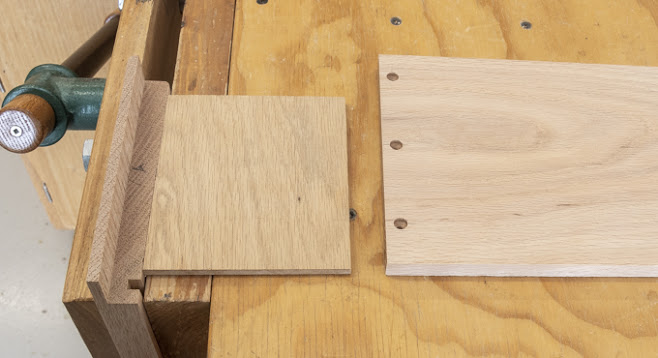Now that all the drawer parts are made assembly can
begin. The photo below has all the tools
needed for screwing the drawer fronts and sides together. 
The first step is to clamp the drawer front in the vice
so the bottom of the rabbit is raised above the bench. Here I use a scrap of ¼” plywood. Second, is make sure the side and front are
flush top and bottom and don’t shift by using an “F” clamp. To make sure the side is tight against the
front a pair long clamps are used. This
is where the of ¼” plywood spacer comes into play. It gives me a little room to get my fingers
around the clamp’s handle to tighten the clamp. 
Third, striking the awl which is the same diameter as the
pilot hole with mallet gives me a marked center to use when drilling the pilot
hole in the front with the silver drill in the upper right. The blue tape on the drill bits are my
control for depth. The plywood spacer
between the drawer front and the clamp provides clearance when drilling the
pilot holes. Last is using the yellow
drill to enlarge the pilot hole in the side to its proper size.

Fifth, with one side done the clamps are removed the
partially assembled drawer flipped over and the other side installed following
the same process completing the drawer as shown. When that’s done the back is slid into place
followed by the bottom. 
Sixth, screwing the back in place is next and follows
almost the same process as the sides.
The one change is that the shank pilot hole in the side is already sized
and does not have to be drilled out.
However, the punch is the wrong size to mark pilot hole in the back and
none of the ones I have fit either. I
did find a nail that fit but the point was too long so it got chucked up in the
lathe and the end filed down to a short conical point.
With punch in hand the holes could be marked, drilled and
the screws installed. The photo below
shows the back clamped in place and the screw started. One other difference is the impact driver is
not used to run the screws in. For
control the variable speed drill is used plus as you can see in the photo the
clutch is set very low at #3 so not much torque is applied to the screw. Once the clutch stops the bit from turning I
quit and run the screw the rest of the way in by hand.

I like consistency in screw location so using a couple of
combination squares easily allows me to mark the screw locations the same
between drawers.
Drilling the countersunk holes are next. Like previously done the fence keeps the
holes the same distance from the back edge and the depth the bit drills is
controlled by a stop on the drill press.
The bottom is then slid into place and clamped so the
bottom is fully set into the groove in the front. A new punch sized to fit the holes is used to
mark the pilot hole in the back. If you
look close at the lower left corner the bottom is marked as “6R” identifying
the 6” deep right-hand drawer. Once the
pilot hole is drilled the screws can be installed and the bottom is secured in
place. There is a little more work to be
done during final assembly after finishing but that comes later.
Here is the stack of completed drawers ready for the next
step which is to disassemble them one at a time then reassemble with glue at
the front, back and sides joints. The
bottom is not permanently secured in place because I want to finish the drawers
without them installed. If you look at the first two small drawers near the back are a couple of light-colored pieces. Those are the dowels that held the mantel together and were cut in half when the blanks were resawn down for the drawer sides.
Next is to remove the bottoms and set them aside to be
reinstalled after finishing. With them
removed the bottomless drawer is clamped to the work bench, the side is
removed, glue added to the side, front and back joints then screwed back into
place. Here the side has had the glue
applied and is ready for the screws to be tightened. This is done to both sides for all six
drawers.
Before I committed to countersinking the screws in the
sides and filling them with plugs, I did some testing using scrap parts from
the drawer fronts and sides to work out the process. Below are some of the test assemblies. 
Searching through my scrap bin I came across a couple
pieces of cherry about an inch thick for making the plugs. There are two sizes of plugs 3/16” and ¼”
diameter and I need 32 of each size.
Since the plugs represent pins, they need to be cut out of end grain and
not face grain. Here is the setup at the
drill press with one of the blanks and the plug cutter.
Once drilled the blank is run through the bandsaw to cut
the plugs free, that’s shown below.
That’s 5 down and about 65 to go so I have some extras.
Next Up – Milling, Installing & Flushing Plugs – Drawer Test Fit – Mounting Drawer Slides


No comments:
Post a Comment